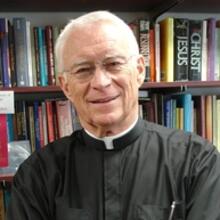Who Speaks for the Church?
The result of the work of a three-year “interest group” that brought together a remarkable number of theologians at the 2009, 2010 and 2011 conventions of the Catholic Theological Society of America, Richard Gaillardetz’s book is an effort to address what he calls the “pronounced magisterial activism” that began under Pope John Paul II and continues with Pope Benedict XVI. He shows in the Introduction that the contemporary magisterium is largely a product of the 19th century. The church of the Middle Ages recognized various modes of teaching authority and a diversity of voices. Theological faculties of the great universities like Paris and Bologna generally arbitrated theological disputes. Aquinas spoke of two magisteria, one of degreed scholars, the other the pastoral teaching office of the bishops. Popes and bishops for centuries played a relatively minor role.
Confronted with an Enlightenment driven protest against religious authority and particularly after the French Revolution, the 19th century papacy began to speak out against what it saw as state interference in the affairs of the church. Pope Pius XI’s “Syllabus of Errors” (1864), rejecting religious liberty and freedom of conscience, is only one example. At the same time, the term magisterium began to be used exclusively of the hierarchy. Pope Leo XIII and Pope Pius X went a stage further when they began to offer extended theological treatments on contemporary issues, while Pius XII in “Humani Generis” (1950) limited the task of theologians to explicating what was proclaimed by pope and bishops.
The result was a process that would transform the papacy from a court of last appeal to a doctrinal watchdog. Under Pope John Paul II the authority of the magisterium was further extended and the role of theologians further limited.
The chapters that follow illustrate these developments. Bradford Hinze reviews a decade of the Vatican’s disciplining of theologians. A partial list of public cases includes 14 scholars, though many others have been investigated or disciplined, particularly those who have written about homosexuality or the ordination of women. Since 1995 four Jesuits have received notifications from the Congregation for the Doctrine of the Faith and 18 Dominicans have been investigated. At least another 11 theologians have been censured or criticized by bishops’ conferences. James Coriden traces from a canonical perspective the development of the National Conference of Catholic Bishops (now the U.S. Conference of Catholic Bishops) document Doctrinal Responsibilities (1989), crafted to deal with doctrinal disputes between bishops and theologians. He suggests the need for simpler procedures and a new joint committee to deal with disputes at both local and national levels.
Colleen Mallon reviews the efforts of religious women to renew their lives following the Second Vatican Council in light of two Vatican inquiries into women religious in the United States, including the current investigation of the Leadership Conference of Women Religious. She asks pointedly if episcopal structures have undergone a similar renewal and redesign, noting that structural reform of the Roman Curia has yet to take place.
Building on Vatican II, Ormond Rush develops the idea that the church’s prophetic or teaching office involves the sensus fidelium, the work of theologians and the magisterium, each charisms of the Spirit. While only the magisterium has final authority, it is dependent on the whole church as the primary recipient of revelation.
Gerard Mannion uses Charles Taylor’s concept of “social imaginary” to illustrate how a particular but narrow understanding of teaching authority has been identified with the word magisterium, at the expense of a more historically conscious theology and other charisms within the church. Two final essays interpret differently the effects of contemporary electronic media on magisterial authority. Anthony Godzieba argues that digital immediacy results in the pope being perceived as a kind of chief executive officer, bishops like corporate vice-presidents and theologians as writers for the corporate newsletter, short-circuiting the more complicated process of discernment, appropriation and doctrinal development, and contributing to a further centralization of authority.
Taking a different perspective, Vincent Miller suggests that digital immediacy also erodes magisterial authority by allowing ever smaller, cyberspace communities with specialized agendas to flourish, diminishing the ability of religious communities to maintain their complex identities. The result is a kind of sectarianism, with high levels of emotion and low levels of religious literacy.
The final part of the book presents as a case study the controversy between Elizabeth Johnson, C.S.J., and the U.S.C.C.B. Committee on Doctrine over her book Quest for the Living God: Mapping Frontiers in Theology. The committee asserted that Johnson’s book “contains misrepresentations, ambiguities, and errors” in regard to authentic Catholic faith. In her response, unfailingly polite, Johnson argues at length that the committee misunderstood and consistently misrepresented her positions, regretting that it did not invite her into a conversation on disputed points before issuing its statement. In a second statement after a response from the committee, Johnson noted some corrections and less vituperative rhetoric, but little movement in understanding.
In his concluding reflections on the ecclesiological issues raised by the Johnson case, Gaillardetz underlines the fundamentally conservative, pastoral task of the bishops in regard to new formulations of the faith, but asks with Johnson if the committee is equating revelation with doctrine, contrary to the more personalist and Trinitarian approach of Vatican II. He finds problematic the current magisterial tendency to rush to doctrinal judgment and the failure of the committee to approach Johnson privately.
Most of all, Gaillardetz argues that if the church’s teaching ministry is to be an expression of the church’s essential nature as a communion, then it must act as a true communio and not as autonomous authority figures. At a time of considerable disagreement over how the church’s teaching authority is being exercised, this is a truly important book.
This article also appeared in print, under the headline “Who Speaks for the Church?,” in the October 15, 2012, issue.








